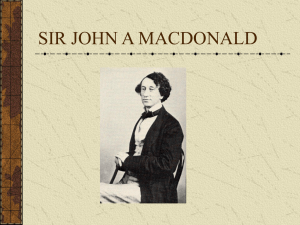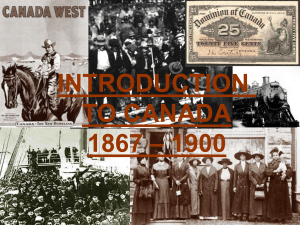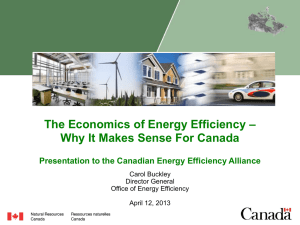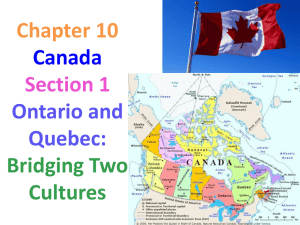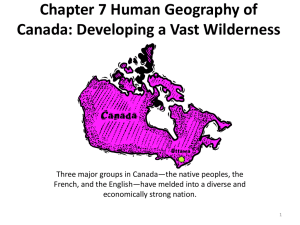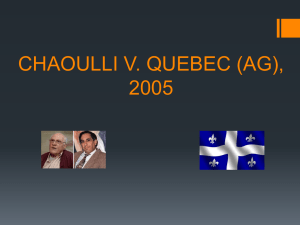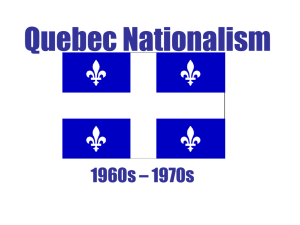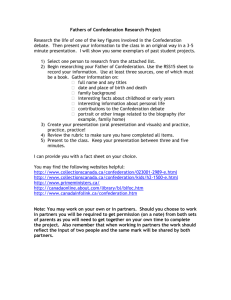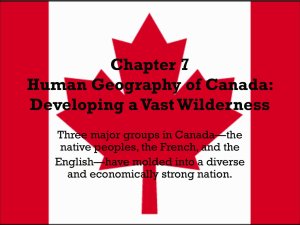Confederation
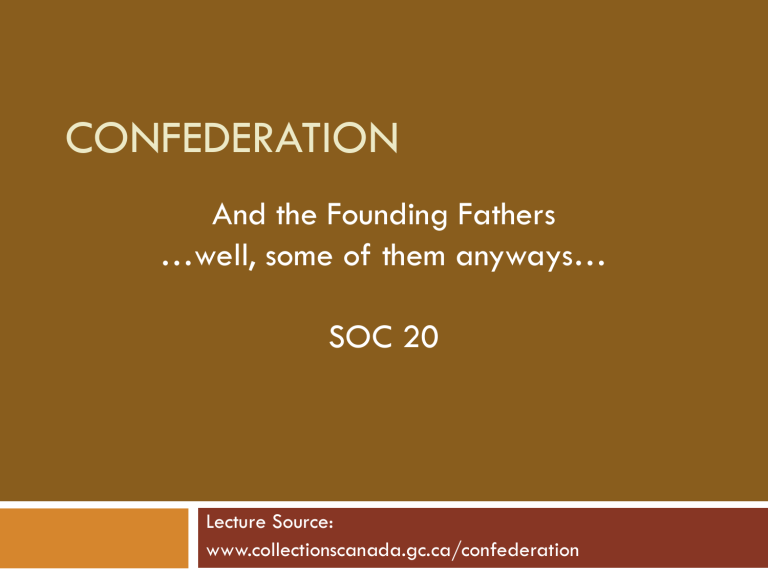
CONFEDERATION
And the Founding Fathers
…well, some of them anyways…
SOC 20
Lecture Source: www.collectionscanada.gc.ca/confederation
Founding Fathers:
The Confederation of Canada was decided in three separate conferences
The 36 delegates of these conferences are considered the original “Founding Fathers” of
Canada
There are others though, that also have a claim to the title of “founding father”
So with so many Candidates, who is the most influential Founding Father?...
Come to your genewine poppy!
~George Brown
I’m the Father of
Confederation
~Sir Francis
Hincks
Gracious! Me own child don’t know me!
~William
McDougall
Don’t it recognize its real daddy?
~Sir John A
Macdonald
George Brown
Was an emigrant from Scotland who founded the Globe newspaper
He quickly entered politics and supported the reformers, who were campaigning for “Rep by Pop”
In 1864, he proposed the “Great Coalition” to John A.
Macdonald and George Etienne Cartier
He played a major role in the Charlottetown and Quebec conferences
He resigned from the coalition in 1865
George Brown
Brown’s recognition of the importance of the
French Canadian perspective has impacted
Quebec to this day
In a speech in 1865, he said:
“Whether we ask for parliamentary reform for Canada alone or in union with the Maritime provinces, the views of French
Canadians must be consulted as well as ours. This scheme can be carried, and no scheme can be that has not the support of both
sections of the province” (that is, united Canada)
Sir Francis Hincks
An emigrant from Ireland and successful businessman in York
Became a close friend of William Warren
Baldwin and his son, Robert Baldwin
He established The Examiner in York with the goal of promoting Responsible Government
This paper later merged with George Brown’s The Globe
Over time, these joint newspapers became known as The Globe and Mail!
Sir Francis Hincks
He was a premier of the province of Canada from 1851-1854
He had a vision of a railroad linking British
North America, which led to the Grand Trunk
Railway
He had a desire for responsible government, and a railroad to unite the vast territory of the North
William McDougall
Practiced law in Toronto and later expanded into journalism
He later dropped journalism and became solely involved in politics
He wanted to see Canada expand to the West and his goal was to acquire the land owned by the Hudson’s Bay
Company
He attended all three conferences leading to
Confederation
William McDougall
He was named Minister of Public Works in
Macdonald’s government of 1867
In 1869, he was named the first lieutenantgovernor of the Northwest Territories
However, Metis led by Louis Riel prevented him from entering the territory (Red River Rebellion)
From then on, he vehemently opposed Manitoba’s efforts to join
Confederation
Believed that power should not be granted to Manitoba until they had a large enough population
Sir John A. Macdonald
An emigrant from Scotland, he studied law at 15 and opened his own office at 19
He helped form the 1854 coalition with the reformers and French Canadians
In 1864, he accepted George Brown’s “Great Coalition” to bring about Constitutional Change
He became the first Prime Minister due to his “nationbuilding efforts”
His vision was of a united country in British North America.
But one where Ontario & Quebec held power
Sir John A. Macdonald
In his first term as Prime Minister he:
Added Manitoba, PEI, and BC as provinces
Acquired the North-West territory that would later become Alberta and Saskatchewan
Began the Intercontinental Railway
Goal: Unite Quebec City and Halifax
In his second term he:
Built the Canadian Pacific Railway (CPR)
Dealt with the Red River Rebellion of Louis Riel
•
•
•
•
The Creation of a Nation
Pressures for Confederation
Charlottetown Conference
Quebec Conference
London Conference
Pressures for Confederation
Internal
Political Deadlock
Desire for an inter-colony railroad to improve trade, military movement, and transportation
Population expansion
Desire for economic development: “economic
nationalism”
External
“Manifest Destiny” and possible invasion from the
USA
The American Civil War and its reactions
The Fenian Raids
Change to British colonial policy (Britain no longer wanted to maintain soldiers in its colonies)
Charlottetown Conference 1864
The Maritime colonies (Nova Scotia, New Brunswick, PEI) were thinking about a Maritime union
Then John A. Macdonald requested that the province of
Canada join the talks
Official proceedings began September 1 st
Little or no public record of what was said. However, the main topics discussed were:
Arguments in favour of a union
Possible financial arrangements
What a united government might look like
It was decided that the Conference warranted additional discussion, to be held in Quebec
Charlottetown Conference 1864
Foundations for the new country:
Preservation of ties with Great Britain
A bicameral system of government
Lower Hhouse = rep by pop, based on elections
Upper House = representation based on regional rather than provincial equality
Responsible government at ALL levels of government
Appointment of a governor general by the British
Crown
Quebec Conference 1864
The Quebec Conference was held where the Chateau Frontenac sits today
Quebec Conference 1864
Attendees: Province of Canada, New Brunswick,
Nova Scotia, PEI, Newfoundland
However, John A. Macdonald was the dominant figure during these talks
Resulted in the creation of the “Quebec Resolutions”
72 resolutions that would form the basis of the new nation
Detailed who would have authority and so on
The Quebec Conference
Quebec Resolutions
1. The best interests and present and future prosperity of
British North America will be promoted by a Federal
Union under the Crown of Great Britain, provided such
Union can be effected on principles just to the several provinces.
17. The basis of representation in the House of Commons shall be population, as determined by the official census every 10 years; and the number of members
Upper Canada 82 Newfoundland
Nova Scotia 19 New Brunswick
8
Lower Canada 65 Prince Edward Island 5
15
Quebec Resolutions
46. Both the English and French languages may be employed in the General Parliament and its proceedings, and in the local legislature of Lower
Canada, and also in the Federal courts and in the
Courts of Lower Canada
68. The General Government shall secure, without delay, the completion of the Intercolonial Railway from Riviere-du-Loup, through New Brunswick, to
Truro in Nova Scotia
London Conference 1866
Held in December, the delegates reviewed the wording of the Quebec resolutions
Following Christmas, these “London Resolutions” were drafted into proposed bills, and delegates met with
British officials to finalize the text
The name “Canada” was easily decided
As well as “Ontario” and “Quebec” for its two parts
Ultimately, the new nation was designated a “dominion”
“He shall have dominion also from sea to sea, and from the river unto the ends of the earth.” – Psalm 72
London Conference
There were difficulties though:
An anti-union delegation from Nova Scotia, led by
Joseph Howe, wanted to overturn any union agreement
They were unsuccessful
The British North America Act 1867
The resulting act of the three conferences received
Royal Assent on March 29, 1867
Union was set to be held on July 1, 1867
There were four initial provinces
1867: Ontario, Quebec, New Brunswick, Nova Scotia
1870: Manitoba, North-West Territories
1871: British Columbia
1873: Prince Edward Island
1898: Yukon
1905: Alberta & Saskatchewan
1949: Newfoundland (Newfoundland & Labrador in 2001)
1999: Nunavut
A Nation is Born
